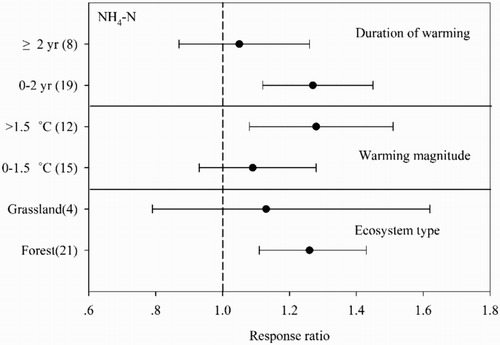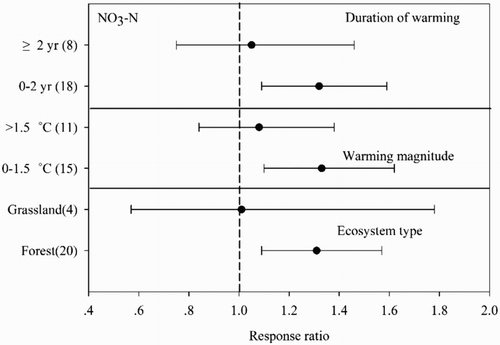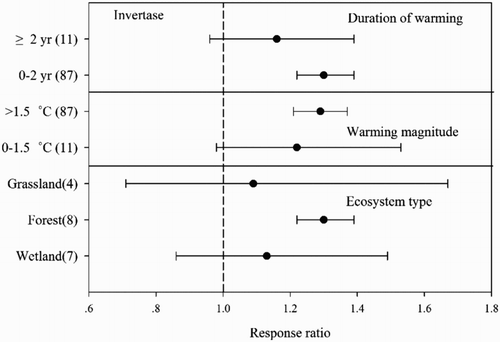ABSTRACT
Soil enzymes are regulate terrestrial carbon (C) and nitrogen (N) cycles, and how the activity of these enzymes are affected by soil warming duration is unclear. In the study, the effect of experimental soil warming duration (<2 years and >2 years) on invertase and urease activities were examined by meta-analysis. Soil warming increased invertase activity by 22% (<2 years) and 16% (>2 years), respectively, while they increased urease by 29% and 9%. Meta-analysis of soil warming experiments found that warming by less than 1.5°C increased invertase by 22%, while warming it by more than 1.5°C increased invertase by 29%; the corresponding increases in urease were 16% and 8%. These effects of experiment warming differed among ecosystem types, with warming-induced increases being greatest in forest ecosystem. The results of this meta-analysis suggest that invertase and urease become less responsive to warming over longer periods and invertase with greater warming-responsiveness than urease activity.
Introduction
Extracellular enzyme activity in soils has been studied for more than a century as part of research on organic matter decomposition, and such activity can serve as an indicator of microbial nutrient demand (Sinsabaugh et al. Citation2008), soil microbial status and soil physico-chemical conditions (Baum et al. Citation2003; Sardans et al. Citation2008). Soil enzymes are thought to be sensitive to environmental changes affecting soil, including agricultural management, heavy metal contamination and soil warming (Chaperon and Sauvé Citation2007; DeForest Citation2009; Bowles et al. Citation2014; Kotroczó et al. Citation2014; Qi et al. Citation2016).
Soil enzyme assays are generally simple, accurate, sensitive and rapid, therefore, they have been used extensively to analyze how environmental changes affect soil metabolism (Nannipieri et al. Citation2012). Frequently assayed soil enzymes include α-glucosidase, N-acetylglucosiminidase and phenoloxidase (Fenner and Freeman Citation2011; McDaniel et al. Citation2013; Wang et al. Citation2014), with the most widely assayed enzymes involved in carbon and nitrogen cycles, including invertase and urease. Invertase activity is often used as an index of C cycling, this enzyme breaks down carbohydrate polymers, releases simpler sugars, increases the content of soluble nutrients in the soil, mediates carbon transformations and produces the main energy sources of soil microorganisms (Sardans et al. Citation2008). Urease activity is often used as an index of N mineralization; it is involved in the hydrolysis of urea, one of the many N organic substrates mineralized to in the soil (Sardans et al. Citation2008; Nannipieri et al. Citation2012).
Soil warming strongly affects enzyme activity, altering C and N cycling in the soil. Clarifying the effects of soil warming on C, N-related enzymes would improve models of how climate change will affect C and N cycling (Nottingham et al. Citation2016), yet this question is challenging to study. While some work has indicated that warming increases soil urease activity (Sardans et al. Citation2008), primarily by increasing microbial activity and therefore release of more enzymes (Gong et al. Citation2015), other studies have reported that warming decreases activity of α-glucosidase, ß-glucosidase and acetylglucisaminidase (Qi et al. Citation2016). Still other studies have reported that the effect of warming on soil enzyme activity vary seasonal and geographical (Bell et al. Citation2010; German et al. Citation2012). It is possible that these contradictory results reflect, in part, heterogeneity in the temperatures and durations of warming analyzed in the literature. Therefore the present meta-analysis was undertaken to assess as comprehensively as possible the effects of warming on soil enzyme activity. The meta-analysis looked separately at effects of short- and long-term heating, since this has yet to be explored systematically, and such analysis may have substantial implications for modeling the effects of global climate change.
Materials and methods
Data collection
ISI Web of Science and Google Scholar were systematically searched in December 2014 to identify studies of the effects of experimental warming on soil enzyme activity using the search terms ‘soil enzyme’ and ‘soil warming’ and ‘carbon’ and ‘short term’ or ‘long term’. A total of 21 studies were identified, including 139 paired observations. The database included invertase, urease and other related parameters (pH, moisture, soil organic carbon (SOC), total nitrogen (TN), -N and
-N).
Data analysis
Results were stratified depending on whether the soil warming was 0–1.5°C or >1.5°C, on whether the warming lasted 0–2 years or >2 years and on the ecosystem type (wetland, grassland, forest, shrub land). For each ecosystem type, data were collected on latitude, mean annual temperature (MAT), mean annual precipitation (MAP) and warming method. When data were expressed as figures or charts, numerical values were extracted using Get Data Graph Digitizer.
We calculated the effects of soil warming on soil enzyme activity and other soil variables at a given site in terms of a response ratio, r = XE/XC, where XE was the mean value of soil variable in soil warming plots, and XC was the mean value in associated control plots (Hedges et al. Citation1999). Mean effect sizes were calculated, and a bias-corrected 95% confidence interval (CI) was determined using the bootstrapping procedure in METAWIN 2.1 (Rosenberg et al. Citation2000). Soil warming effects were considered significant at the level P < 0.05 if the associated 95% CI did not include 1 (Liu and Greaver Citation2010). Total heterogeneity among groups (Qt) was partitioned into within-group heterogeneity (Qw) and between-group heterogeneity (Qb). Qb was determined for each categorical response variable; a significant Qb indicated significantly different effect sizes between warming conditions.
Results
Effects of experimental soil warming on pH, soil moisture and content of C and N
Warming was associated with a 1–2% decrease in pH (), and a 1–16% decrease in soil moisture (); the decrease in moisture was greater in grasslands than in forests or shrub lands. Warming of up to 2 years increased soil organic matter by 3–6%, while warming longer than 2 years decreased soil organic matter. These changes in soil organic matter were greater in shrub lands and forests than in wetlands (). Soil warming decreased total nitrogen content, whereas the content of and
increased; the magnitude of
and
increases depended on warming duration and magnitude ().
Figure 1. Meta-analysis of the effects of warming duration, warming magnitude, and ecosystem type on pH. Dots indicate the pooled mean response ratio, and horizontal bars indicate the associated 95% CI.
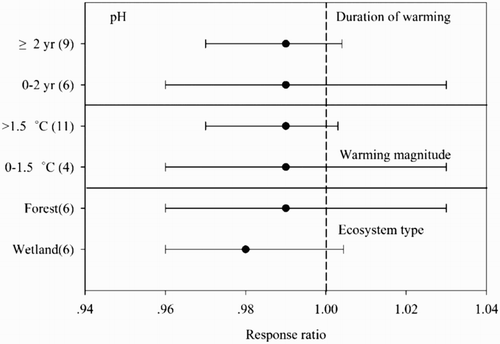
Figure 2. Meta-analysis of the effects of warming duration, warming magnitude and ecosystem type on soil moisture. Dots indicate the pooled mean response ratio, and horizontal bars indicate the associated 95% CI.
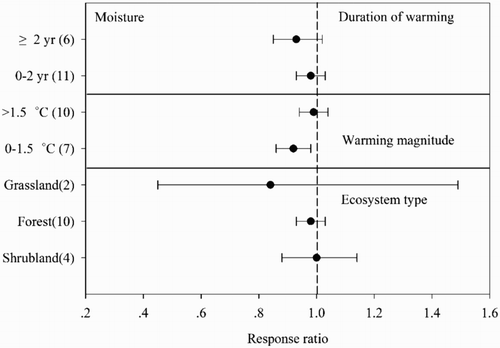
Figure 3. Meta-analysis of the effects of warming duration, warming magnitude and ecosystem type on soil organic matter. Dots indicate the pooled mean response ratio, and horizontal bars indicate the associated 95% CI.
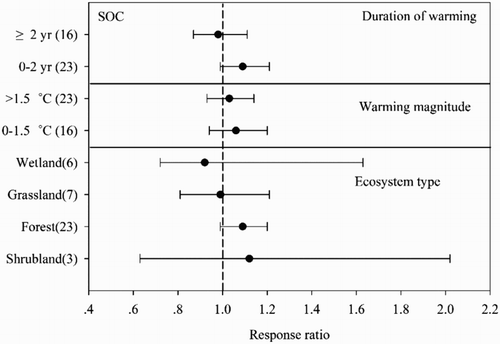
Figure 4. Meta-analysis of the effects of warming duration, warming magnitude and ecosystem type on total nitrogen. Dots indicate the pooled mean response ratio, and horizontal bars indicate the associated 95% CI.
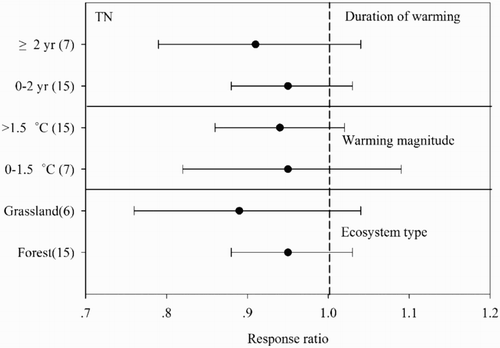
Effects of experimental warming on soil invertase activity
Soil warming increased invertase activity, and the magnitude of the increase depended on warming duration, temperature increase and ecosystem (). Invertase activity increased by 22% after up to 2 years of soil warming and by 16% after >2 years of warming. Invertase activity increased by 22% with warming of 0–1.5°C and by 29% with warming >1.5°C. Invertase activity increased by 9% in grasslands, 30% in forests and 13% in wetlands.
Effects of experimental warming on soil urease activity
The effect of soil warming on soil properties in different ecosystem are shown in . Significant values of the Qb test indicated that soil urease activity were sensitive to warming magnitude and warming duration. Soil urease activity also varied with different ecosystems.
Table 1. Categorical variables and the test of heterogeneity between groups (Qb) using meta-analysis.
Soil warming increased urease activity, and the magnitude of the increase depended on warming duration, temperature increase and ecosystem (). Urease activity increased by 29% after up to 2 years of soil warming, with a smaller increase occurring after >2 years of warming (). Urease activity increased by 16% with warming of 0–1.5°C and by 8% with warming >1.5°C. Urease activity increased by 32% in forests, significantly more than in wetlands (9%), grasslands (9%) and shrub lands (10%).
Discussion
Temperature is a determinant of soil enzyme production (Sardans et al. Citation2006, Citation2008; Allison and Treseder Citation2008) and our meta-analysis indicates that soil warming affects soil invertase and urease activities. For example, it increases urease activity by 8–29% () which also increased inorganic N pools ( and ) because ureases hydrolysis urea, releasing -N (Zantuaa and Bremnera Citation1977) as demonstrated in recent work (Wang et al. Citation2014). Soil warming also increases invertase activity by 16–30% in various ecosystems (), consistent with previous work in forest ecosystem (Xu et al. Citation2010; Wang et al. Citation2014). Since the activity of invertase and other enzymes is thought to correlate with microbial activity, our results are consistent with the idea that soil warming stimulates microbial activity (Xu et al. Citation2010). Our findings on warming-induced increases in invertase and urease activity are also consistent with previous work (Sardans et al. Citation2008). The slightly larger increase in activity for invertase than for urease observed in this meta-analysis showing that enzymatic reaction induced C-cycle may be more temperature-responsive than N-cycle (Wallenstein et al. Citation2009).
The responses of soil enzyme activity to experimental warming differed among the ecosystem types. Our result found that warming-induced increases in soil enzyme activity were higher in forest ecosystems (invertase, 30%; urease, 32%) than in grassland or wetland ( and ). This greater increase may reflect the shorter duration of warming, since most experiments in forests involved warming for <1 year. Short-term warming experiments in forest may increase soil enzyme activity simply because (a) installation of soil warming instruments disturbs the soil structure, exposes soil to the air and accelerates production of soil enzymes, (b) death of plant roots during the study can accelerate mineralization (Dinsmore et al. Citation2009), and (c) the abundant roots and other materials in forest soil act as substrates for microbial growth, leading to greater soil enzyme production (German et al. Citation2012; Gong et al. Citation2015). Installation of soil warming equipment may also help explain why short-term warming induced larger increases in soil enzyme activity than long-term warming in non-forest ecosystems. Several techniques have been developed for soil warming, including open-top chambers, passive warming curtains, greenhouses, infrared heaters and cable heating (Aronson et al. Citation2009; Henry Citation2012; Johnson et al. Citation2013). All these systems disturb surface soil in the early stage of the experiment, which would increase the production of soil enzymes.
These results have implications for modeling the effects of climate change on C, N-related process in soil. It is evident from our results that warming-induced increases in urease activity changes the N pool, while increases in invertase activity enhance soil organic carbon dynamic in soil ( and ). These results also reported by previous studies (Fenner et al. Citation2007; Fenner and Freeman Citation2011), and they found the changing carbon dynamic could potentially affects atmospheric CO2 emission (Weedon et al. Citation2011; Henry Citation2012). In our study, we also found that the soil warming could induced different degree of soil acidification and drought ( and ). This trend could significantly affect soil process under climate change. These results clear evidence that if soil warming continues as part of global climate change, C, N-cycling is likely to be significantly affected through C, N-related soil enzyme.
Disclosure statement
No potential conflict of interest was reported by the authors.
Notes on contributors
Yinping Bai is a research assistant in crop science at Southwest University of Science and Technology. Her research focuses on crop cultivation.
Feng Li is associate professor in wetland ecology at the Institute of Subtropical Agriculture, The Chinese Academy of Sciences, Hunan, China. He is active in the research area of wetlands plants.
Gang Yang is a lecturer in ecology at Southwest University of Science and Technology. His interest area is in peatland carbon cycles including CH4 and CO2 monitoring.
Shengwei Shi is a lecturer in plant nutrients at Beijing University of Agriculture. He is active in the research area of plant science and soil processes.
Faqin Dong is a professor in minerology at Southwest University of Science and Technology. He is interested in soil processes and their effect on atmospheric pollution.
Mingxue Liu is a professor in microbiology at Southwest University of Science and Technology. His research is on the environment effect on soil microorganisms.
Xiaoqin Nie is an assistant professor in plant science at Southwest University of Science and Technology. She is active in the research area of soil remediation using hyper accumulator plants.
Jiangbo Hai is a professor in agronomy at Northwest A&F University, Yangling, China. He provides technical support on agricultural production.
Additional information
Funding
References
- Allison SD, Treseder KK. 2008. Warming and drying suppress microbial activity and carbon cycling in boreal forest soils. Global Change Biol. 14:2898–2909. doi: 10.1111/j.1365-2486.2008.01716.x
- Aronson EL, Mcnulty SG, Sun G, Sun JX, Zhou GS. 2009. Appropriate experimental ecosystem warming methods by ecosystem, objective, and practicality. Agr Forest Meteorol. 149:1791–1799. doi: 10.1016/j.agrformet.2009.06.007
- Baum C, Leinweber P, Schlichting A. 2003. Effects of chemical conditions in re-wetted peats on temporal variation in microbial biomass and acid phosphatase activity within the growing season. Appl Soil Ecol. 22:167–174. doi: 10.1016/S0929-1393(02)00129-4
- Bell TH, Klironomos JN, Henry HA. 2010. Seasonal responses of extracellular enzyme activity and microbial biomass to warming and nitrogen addition. Soil Sci Soc Am J. 74:820–828. doi: 10.2136/sssaj2009.0036
- Bowles TM, Acosta-Martínez V, Calderón F, Jackson LE. 2014. Soil enzyme activities, microbial communities, and carbon and nitrogen availability in organic agroecosystems across an intensively-managed agricultural landscape. Soil Biol Biochem. 68:252–262. doi: 10.1016/j.soilbio.2013.10.004
- Chaperon S, Sauvé S. 2007. Toxicity interaction of metals (Ag, Cu, Hg, Zn) to urease and dehydrogenase activities in soils. Soil Biol Biochem. 39:2329–2338. doi: 10.1016/j.soilbio.2007.04.004
- DeForest JL. 2009. The influence of time, storage temperature, and substrate age on potential soil enzyme activity in acidic forest soils using MUB-linked substrates and l-DOPA. Soil Biol Biochem. 41:1180–1186. doi: 10.1016/j.soilbio.2009.02.029
- Dinsmore KJ, Skiba UM, Billett MF, Rees RM. 2009. Effect of water table on greenhouse gas emissions from peatland mesocosms. Plant and Soil. 318:229–242. doi: 10.1007/s11104-008-9832-9
- Fenner N, Freeman C. 2011. Drought-induced carbon loss in peatlands. Nat Geo. 4:895–900. doi: 10.1038/ngeo1323
- Fenner N, Freeman C, Lock MA, Harmens H, Reynolds B, Sparks T. 2007. Interactions between elevated CO2 and warming could amplify DOC exports from peatland catchments. Environ Sci Tech. 41:3146–3152. doi: 10.1021/es061765v
- German DP, Marcelo KRB, Stone MM, Allison SD. 2012. The Michaelis–Menten kinetics of soil extracellular enzymes in response to temperature: a cross-latitudinal study. Global Change Biol. 18:1468–1479. doi: 10.1111/j.1365-2486.2011.02615.x
- Gong S, Zhang T, Guo R, Cao H, Shi L, Guo J, Sun W. 2015. Response of soil enzyme activity to warming and nitrogen addition in a meadow steppe. Soil Research. 53:242–252. doi: 10.1071/SR14140
- Hedges LV, Gurevitch J, Curtis PS. 1999. The meta-analysis of response ratios in experimental ecology. Ecology. 80:1150–1156. doi: 10.1890/0012-9658(1999)080[1150:TMAORR]2.0.CO;2
- Henry HAL. 2012. Soil extracellular enzyme dynamics in a changing climate. Soil Biol Biochem. 47:53–59. doi: 10.1016/j.soilbio.2011.12.026
- Johnson CP, Pypker TG, Hribljan JA, Chimner RA. 2013. Open top chambers and infrared lamps: a comparison of heating efficacy and CO2/CH4 dynamics in a Northern Michigan Peatland. Ecosystems. 16:736–748. doi: 10.1007/s10021-013-9646-3
- Kotroczó Z, Veres Z, Fekete I, Krakomperger Z, Tóth JA, Lajtha K, Tóthmérész B. 2014. Soil enzyme activity in response to long-term organic matter manipulation. Soil Biol Biochem. 70:237–243. doi: 10.1016/j.soilbio.2013.12.028
- Liu L, Greaver TL. 2010. A global perspective on belowground carbon dynamics under nitrogen enrichment. Ecol Lett. 13:819–828.
- McDaniel MD, Kaye JP, Kaye MW. 2013. Increased temperature and precipitation had limited effects on soil extracellular enzyme activities in a post-harvest forest. Soil Biol Biochem. 56:90–98. doi: 10.1016/j.soilbio.2012.02.026
- Nannipieri P, Landi L, Giagnoni L, Renella G. 2012. Past, present and future in soil enzymology. In: Trasar-Cepeda C, Hernandez T, Garcia C, Rad C, Gonzalez-Carcedo S, editors. Soil enzymology in the recycling of organic wastes and environmental restoration, environmental science and engineering. Berlin: Springer-Verlag; p. 1–17.
- Nottingham AT, Turner BL, Whitaker J, Ostle N, Bardgett RD, McNamara NP, Salinas N, Meir P. 2016. Temperature sensitivity of soil enzymes along an elevation gradient in the Peruvian Andes. Biogeochemistry. 127:217–230. doi: 10.1007/s10533-015-0176-2
- Qi R, Li J, Lin Z, Li Z, Li Y, Yang X, Zhang J, Zhao B. 2016. Temperature effects on soil organic carbon, soil labile organic carbon fractions, and soil enzyme activities under long-term fertilization regimes. Appl Soil Ecol. 102:36–45. doi: 10.1016/j.apsoil.2016.02.004
- Rosenberg MS, Adams DC, Gurevitch J. 2000. MetaWin: statistical software for meta-analysis. Sunderland, MA: Sinauer Associates.
- Sardans J, Peñuelas J, Estiarte M. 2006. Warming and drought alter soil phosphatase activity and soil P availability in a Mediterranean shrubland. Plant Soil. 289:227–238. doi: 10.1007/s11104-006-9131-2
- Sardans J, Peñuelas J, Estiarte M. 2008. Changes in soil enzymes related to C and N cycle and in soil C and N content under prolonged warming and drought in a Mediterranean shrubland. Appl Soil Ecol. 39:223–235. doi: 10.1016/j.apsoil.2007.12.011
- Sinsabaugh RL, Lauber CL, Weintraub MN, Ahmed B, Allison SD, Crenshaw C, Contosta AR, Cusack D, Frey S, Gallo ME. 2008. Stoichiometry of soil enzyme activity at global scale. Ecol Lett. 11:1252–1264.
- Wallenstein MD, Mcmahon SK, Schimel JP. 2009. Seasonal variation in enzyme activities and temperature sensitivities in Arctic tundra soils. Global Change Biol. 15:1631–1639. doi: 10.1111/j.1365-2486.2008.01819.x
- Wang X, Dong S, Gao Q, Zhou H, Liu S, Su X, Li Y. 2014. Effects of short-term and long-term warming on soil nutrients, microbial biomass and enzyme activities in an alpine meadow on the Qinghai-Tibet Plateau of China. Soil Biol Biochem. 76:140–142. doi: 10.1016/j.soilbio.2014.05.014
- Weedon JT, Rien A, Kowalchuk GA, Van Bodegom PM. 2011. Enzymology under global change: organic nitrogen turnover in alpine and sub-Arctic soils. Biochem Soc Trans. 39:309–314. doi: 10.1042/BST0390309
- Xu Z-f, Hu R, Xiong P, Wan C, Cao G, Liu Q. 2010. Initial soil responses to experimental warming in two contrasting forest ecosystems, Eastern Tibetan Plateau, China: nutrient availabilities, microbial properties and enzyme activities. Appl Soil Ecol. 46:291–299. doi: 10.1016/j.apsoil.2010.07.005
- Zantuaa MI, Bremnera JM. 1977. Stability of urease in soils. Soil Biol Biochem. 9:135–140. doi: 10.1016/0038-0717(77)90050-5

